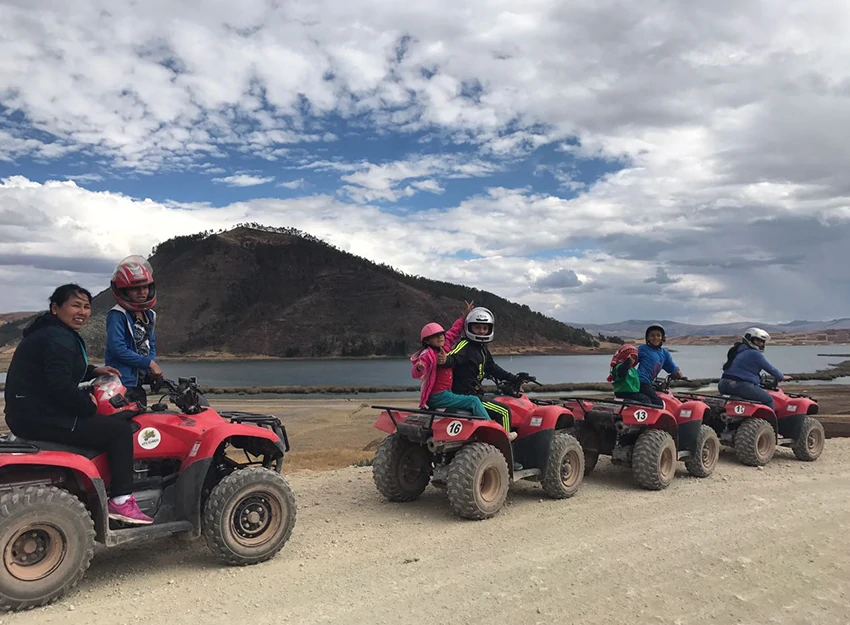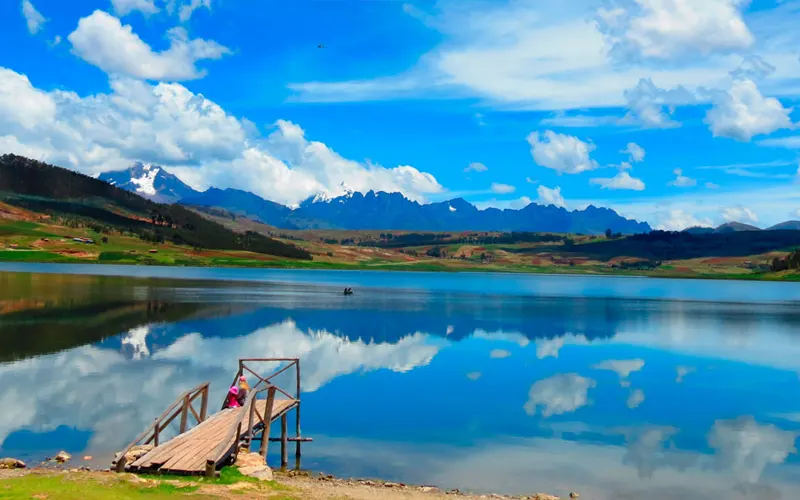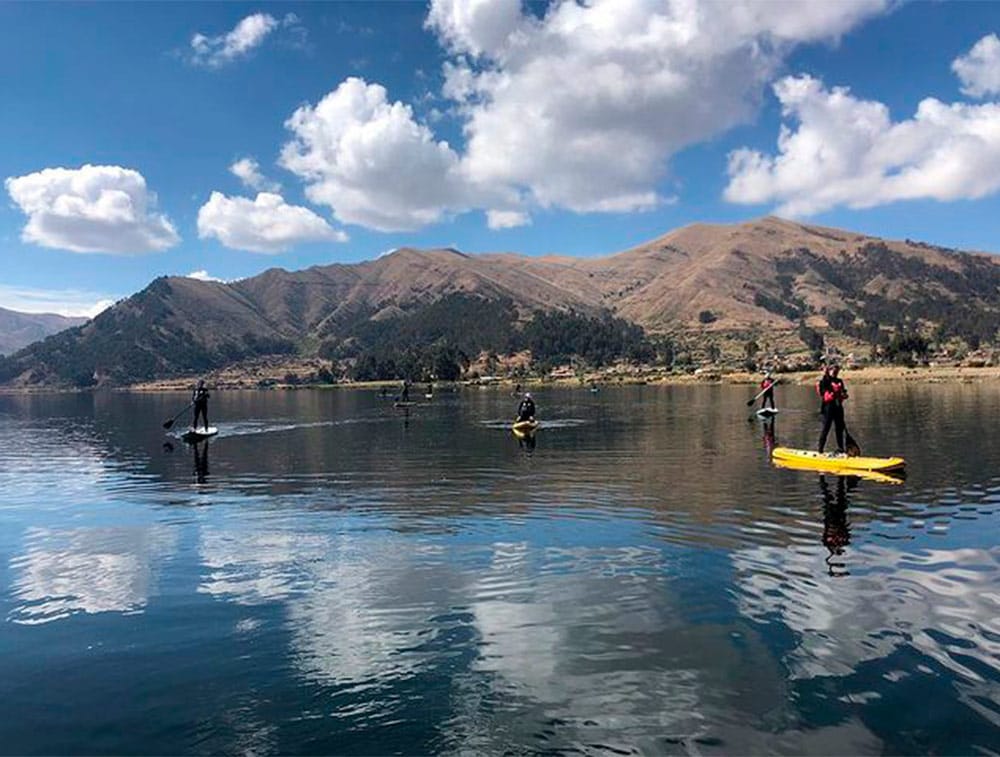Lake Piuray in Cusco is one of Peru’s most captivating natural destinations. Located in the majestic Andean region of Chinchero, this natural lake offers a unique sustainable tourism experience, ideal for those looking to disconnect and explore authentic Cusco landscapes. With its serene waters surrounded by mountains and clear skies, Piuray blends adventure, living culture, and tranquility, making it a must-visit for any traveler wanting to experience the best of eco and cultural tourism in the Sacred Valley of the Incas.
Location and Accessibility
How to get there from Cusco city
Visiting Lake Piuray from Cusco is easy and accessible. The trip starts in the historic center of the city heading towards the district of Chinchero, located about 31 kilometers northwest. From there, a short 8 to 10-minute ride by taxi or mototaxi will take you directly to the lake’s shore. This route also offers panoramic views of the Andean landscapes, making the journey part of the experience.
Available transport options
- Buses and colectivos: Depart daily from Cusco to Chinchero. They are affordable and safe.
- Private taxis or mototaxis: Ideal for small groups or those who prefer more direct transportation.
- Guided tours: Tour companies offer packages including transportation, specialized guides, and recreational activities at the lake.
These alternatives make getting to Lake Piuray simple for both national and international tourists.

Distance and Estimated Travel Time
The distance from Cusco city to Lake Piuray is approximately 31.9 km via paved road. The journey takes between 50 and 60 minutes depending on traffic and the mode of transport chosen. It’s perfect for a half-day visit or as part of a broader Sacred Valley itinerary.
Importance of Lake Piuray
Potable water supply to Cusco
Lake Piuray plays a strategic role in supplying potable water to the city of Cusco. Approximately 40% of the water consumed by the urban population comes from this natural source. Its conservation is key not only for tourism but also for the well-being of thousands of Cusco families.
Role in the local ecosystem
Beyond its water function, Lake Piuray supports a diverse ecosystem. It is home to wild birds such as herons and Andean ducks, and aquatic species like trout. Traditional Andean crops are also cultivated around it, including native potatoes, quinoa, and barley. All of this makes it a high-value ecological destination.

Tourist Activities at Lake Piuray
Available water sports
Lake Piuray is perfect for those wanting to mix nature with adventure. Thanks to its calm and shallow waters, it’s ideal for non-motorized sports like kayaking, paddle boarding (SUP), and canoeing. These activities are safe, even for beginners, and let you explore the lake from a privileged perspective.
Kayaking and stand-up paddleboarding
Kayaking in Lake Piuray is one of the most popular activities. Gliding over its crystal-clear waters surrounded by mountains provides a unique sense of connection with nature. Paddle boarding, meanwhile, is great for improving balance while enjoying the scenery from a stable platform.
Some agencies offer:
- 2 to 3-hour tours with an instructor.
- Professional equipment.
- Combined options with cultural experiences.

Cycling and hiking around the area
The trails around Piuray are perfect for mountain biking and hiking enthusiasts. There are scenic routes connecting to natural viewpoints, small farming villages, and traditional fields. These hikes offer a close-up experience of Cusco’s rural surroundings and natural beauty, far from mass tourism.
Visits to Chinchero and its textile centers
Chinchero is a town with a strong Andean identity. Visitors can explore community-run textile centers preserving ancestral spinning and dyeing techniques. Joining these experiences is a great way to understand Cusco’s cultural richness while directly supporting local communities.
Rainy Season vs. Dry Season
The climate in Piuray is typical of the southern Peruvian highlands. From April to October, the weather is dry with sunny days and temperatures around 20°C. From November to March is the rainy season, with cloudy skies and cooler temperatures, ideal for photographing lush green landscapes.
Climate-based Recommendations
- Dry season: Ideal for water sports, hiking, and cycling.
- Rainy season: Great for those seeking solitude and a greener, more introspective setting. A raincoat is essential.
What to Bring for a Comfortable Experience
Proper clothing and necessary gear
- Windbreaker or rain jacket
- Sports or trekking shoes
- Hat or cap
- Sunglasses and sunscreen
- Water and healthy snacks
- Camera or smartphone to capture the scenery
Available Tour Packages
Currently, several agencies offer customized tours to Lake Piuray for both individual travelers and groups. Some packages include:
- Private transportation
- Activities (kayaking, paddleboarding, cycling)
- Visits to craft centers
- Traditional lunch
- Bilingual guide
Booking in advance is key, especially during peak season (May–August).
Legends About the Lake’s Formation
Lake Piuray is also surrounded by mysticism. According to a Quechua legend, the lake formed from the tears of an Inca princess, or as a divine intervention by the Sun to provide water to his people. These stories are part of the Andean worldview that grants a sacred character to many water bodies.
Cultural Importance to the Local Community
For local communities, Piuray is more than a water source. It is considered a living and sacred being, and offerings and gratitude rituals are still held as part of the Andean spiritual tradition. These events allow visitors to witness ancient practices that have remained alive for centuries.
Accommodation and Gastronomy
Where to Stay in Chinchero and Surroundings
Those who wish to spend more time in the area can stay in:
- Eco-cabins facing the lake
- Family-run hostels in Chinchero
- Rural houses offering experiential tourism
These lodgings offer peace, Andean sunrises, and local hospitality.
Typical Dishes to Try in the Region
The Sacred Valley’s cuisine is nutritious and delicious. Some typical dishes you can find in local restaurants and eateries include:
- Fried or steamed trout
- Oven-roasted guinea pig with native potatoes
- Hen broth or quinoa soup
- Humitas, corn with cheese, and tamales
- Muña and coca infusions for altitude